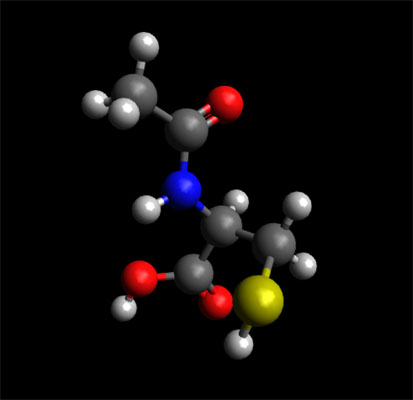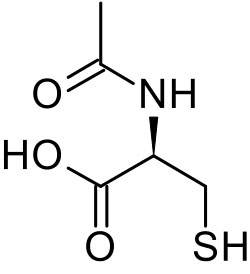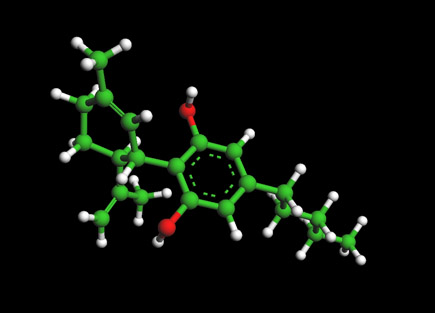N-Acetyl-Cysteine (NAC) as a Senolytic and Anti-Aging Molecule

Ball and Stick Model for N-acetyl-cysteine Molecule
N-acetyl-cysteine Molecule (above) Ball-and-stick. For 3D Jsmol File
Molecular formula -- C5H9NO3S
Molar mass -- 163.195 g·mol−1
About NAC
Acetylcysteine, also known as N-acetylcysteine (NAC), is a modified amino acid that is used as an antidote for acetaminophen overdose to prevent hepatic injury. Acetylcysteine is a hepatoprotective agent and has not been linked to significant serum enzyme elevations during therapy or to instances of clinically apparent acute liver injury. N-acetyl-L-cysteine is an N-acetyl-L-amino acid that is the N-acetylated derivative of the natural amino acid L-cysteine. It has a role as an antiinfective agent, an antioxidant, an antiviral drug, an antidote to paracetamol poisoning, a vulnerary, a mucolytic, a human metabolite and a radical scavenger. It is a L-cysteine derivative, an acetylcysteine and a N-acetyl-L-amino acid. It is a conjugate acid of a N-acetyl-L-cysteinate.

N-acetyl-cysteine molecular structure
About NAC
From --- Boosting levels of known antioxidant may help resist age-related decline Date: October 24, 2016
Source: Oregon State UniversitySummary: A specific detoxification compound, glutathione, helps resist the toxic stresses of everyday life – but its levels decline with age and this sets the stage for a wide range of age-related health problems, scientists have discovered.
"What this study pointed out was the way that cells from younger animals are far more resistant to stress than those from older animals," said Hagen, also a professor of biochemistry in the OSU College of Science. "In young animal cells, stress doesn't cause such a rapid loss of glutathione.
 Glutathione Molecular Structure
Glutathione Molecular Structure
The cells from older animals, on the other hand, were quickly depleted of glutathione and died twice as fast when subjected to stress. "But pretreatment with NAC increased glutathione levels in the older cells and largely helped offset that level of cell death."
Glutathione is a tripeptide with a gamma peptide linkage between the carboxyl group of the glutamate side chain and cysteine. The carboxyl group of the cysteine residue is attached by normal peptide linkage to glycine.
ABSTRACTS
21 December 2016 --- A Review on Various Uses of N-Acetyl Cysteine
N-acetyl cysteine (NAC), as a nutritional supplement, is a applied antioxidant in vivo and in vitro. NAC is a precursor of L-cysteine that results in glutathione elevation biosynthesis. It acts directly as a scavenger of free radicals, especially oxygen radicals. NAC is a powerful antioxidant. It is also recommended as a potential treatment option for different disorders resulted from generation of free oxygen radicals. Additionally, it is a protected and endured mucolytic drug that mellows tenacious mucous discharges. It has been used for treatment of various diseases in a direct action or in a combination with some other medications. This paper presents a review on various applications of NAC in treatment of several diseases. Keywords: N-Acetyl Cysteine, Antioxidant, Oxidative Stress.... it is believed that NAC can decrease the frequency of aggravations and improve symptoms in patients with chronic bronchitis. Recently, a comprehensive review in literature survey has concluded in the field of the effectiveness of any oral mucolytic drugs that a decline of aggravations, days of disability and days of antibiotic treatment was averagely determined in patients with chronic clogging pulmonary disease....Results of different studies showed that lipoic acid (LA) and NAC decreased levels of oxidative and apoptotic markers via protection of mitochondrial function (50,53). Combination of both LA and NAC maximizes this protective effect suggesting that this may prevent mitochondrial decay associated with aging and age-related disorders such as AD. Antioxidant therapies based on LA and NAC seem promising since they can act on mitochondria, one key source of oxidative stress in aging and neurodegeneration (50).". see full publication and references therein
13 Dec ember 2018 Overview on the Effects of N-Acetylcysteine in Neurodegenerative Diseases
N-acetylcysteine (NAC), which is an acetylated cysteine compound, has aroused scientific interest for decades due to its important medical applications. It also represents a nutritional supplement in the human diet. NAC is a glutathione precursor and shows antioxidant and anti-inflammatory activities. In addition to the uses quoted in the literature, NAC may be considered helpful in therapies to counteract neurodegenerative and mental health diseases. Furthermore, this compound has been evaluated for its neuroprotective potential in the prevention of cognitive aging dementia. NAC is inexpensive, commercially available and no relevant side effects were observed after its administration. The purpose of this paper is to give an overview on the effects and applications of NAC in Parkinson's and Alzheimer's disorders and in neuropathic pain and stroke. Keywords: N-acetylcysteine, glutathione precursor, oxidative stress, Parkinson's disease, Alzheimer's disease, neuropathic pain, stroke... see full publiccation
August 2018 --N-acetylcysteine Treatment Reduces Age-related Hearing Loss and Memory Impairment in the Senescence-Accelerated Prone 8 (SAMP8) Mouse Model.
Age-related hearing loss (ARHL) is the most common sensory disorder in the elderly population. SAMP8 mouse model presents accelerated senescence and has been identified as a model of gerontological research. SAMP8 displays a progressive age-related decline in brain function associated with a progressive hearing loss mimicking human aging memory deficits and ARHL. The molecular mechanisms associated with SAMP8 senescence process involve oxidative stress leading to chronic inflammation and apoptosis. Here, we studied the effect of N-acetylcysteine (NAC), an antioxidant, on SAMP8 hearing loss and memory to determine the potential interest of this model in the study of new antioxidant therapies. We observed a strong decrease of auditory brainstem response thresholds from 45 to 75 days of age and an increase of distortion product amplitudes from 60 to 75 days in NAC treated group compared to vehicle. Moreover, NAC treated group presented also an increase of memory performance at 60 and 105 days of age. These results confirm that NAC delays the senescence process by slowing the age-related hearing loss, protecting the cochlear hair cells and improving memory, suggesting that antioxidants could be a pharmacological target for age-related hearing and memory loss. source
May 2015 -- Lifespan extension and increased resistance to environmental stressors by N-Acetyl-L-Cysteine in Caenorhabditis elegans
OBJECTIVE: This study was performed to determine the effect of N-acetyl-L-cysteine, a modified sulfur-containing amino acid that acts as a strong cellular antioxidant, on the response to environmental stressors and on aging in C. elegans.
RESULTS: Dietary N-acetyl-L-cysteine supplementation significantly increased resistance to oxidative stress, heat stress, and UV irradiation in C. elegans. In addition, N-acetyl-L-cysteine supplementation significantly extended both the mean and maximum lifespan of C. elegans. The mean lifespan was extended by up to 30.5% with 5 mM N-acetyl-L-cysteine treatment, and the maximum lifespan was increased by 8 days. N-acetyl-L-cysteine supplementation also increased the total number of progeny produced and extended the gravid period of C. elegans. The green fluorescent protein reporter assay revealed that expression of the stress-responsive genes, sod-3 and hsp-16.2, increased significantly following N-acetyl-L-cysteine treatment.
CONCLUSION: N-acetyl-L-cysteine supplementation confers a longevity phenotype in C. elegans, possibly through increased resistance to environmental stressors. see full publication
December 1997 -- N-acetylcysteine slows down ageing and increases the life span of Drosophila melanogaster.
Ageing can be defined as the time-dependent decline of physiological functions of an organism. The molecular causes for the ageing process are multiple, involving both genetic and environmental factors. It has been proposed that antioxidants may positively influence the ageing process, protecting the organism against free radical-induced damage. Here we show that the antioxidant N-acetylcysteine (NAC) has a life-extending effect on Drosophila melanogaster. Dietary uptake of NAC results in a dose-dependent increase in median and maximum life span. Flies fed on 1 mg/ml NAC food live 16.6% longer; at 10 mg/ml, life span increases by 26.6%. We have examined the effect of NAC treatment on protein and RNA levels: we observe an NAC-dependent increase in absolute amounts of total RNA and ribosomal RNA, but no differences in protein levels. The NAC effect on longevity may involve differential expression of specific mRNA genes, as suggested by RNA finger-printing experiments. .. sourceAnti-Aging and Senolytics Home Page
- What is Anti-Aging Medicine
- What is Senescence?
- What are Senolytics?
- About Caloric Restriction
- Mtor and Rapamycin
- The IKK/NF-κB signaling pathway in aging
- Exercise and Anti-Aging
- Meditation and Anti-Aging
SENOLYTIC AND ANTI-AGING MOLECULES
RAPAMYCIN ---The mechanistic target of rapamycin (mTOR) pathway has a central role in cell activation...
METFORMIN -- The diabetes drug metformin used by some for anti-aging may diminish benefits of aerobic exercise...
QUERCETIN-- AND WITH DASATINIB--The senolytic cocktail, dasatinib plus quercetin, which causes selective elimination of senescent cells...
FISETIN--Of the 10 flavonoids tested, fisetin was the most potent senolytic...
EGCG- The most active component of green tea....
NAD BOOSTERS --'...The cells of the old mice were indistinguishable from the young mice, after just one week of treatment...
SULFORAPHANE-- An isothiocyanate present in cruciferous vegetables activates antioxidant and anti-inflammatory responses by ...
UROLITHIN --Metabolite of Pomegranate compound with anti-aging effects passes human trial...
MITO-Q -- A water soluble fomr of CoQ10 that has excellent absorption and high bioavailability...
HONOKIOL - A bioactive natural product derived from Magnolia Bark have demonstrated ...
CURCUMIN AND ANALOGS -Recent research is focused on the design and synthesis of curcumin analogs as antiproliferative and anti-inflammatory agents...
BERBERINE --berberine has recently been reported to expand life span in Drosophila melanogaster, and attenuate premature cellular senescence
N-ACETYL-CYSTINE (NAC)--"...pretreatment with NAC increased glutathione levels in the older cells and largely helped offset that level of cell death..."
PIPERLONGUMINE - A natural product from the Long pepper with high bioavailability...
RESVERATROL AND PTEROTSILBINE -- Pterostilben chemically similar to resveratrol bute differs from resveratrol by exhibiting increased bioavailability (80% compared to 20% in resveratrol)
SPERMIDINE--Spermidine delays aging in humans ...
ALLICIN -- Allicin is a compound produced when garlic is crushed or chopped. ...
VITAMIN D3 -- Production of the active forms of Vitamin D are reduced by 50% as a result of an age-related decline
VITAMIN K-- evidence suggests vitamin K has an anti-inflammatory action
TOCOTRIENOL(AND WITH QUERCETIN) --Tocotrieniols have been found to exert a synergistic antitumor effect on cancer cells when given in combination....
HSP-90 INHIBITORS --As a novel class of senolytics
The Cannabidiol Molecule
Cannabidiol (CBD is the major non-psychoactive component of Cannabis and is being looked at by major drug and consumer companies for various medical and social uses.